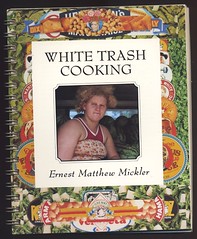On the Road 7: VA & NC, Pt. 1
 fig. a: Blue Ridge view
fig. a: Blue Ridge view
Sometimes the Mason-Dixon Line, and points south, can seem like worlds away--and, in a sense, they are. But it only takes the better part of a day to drive down from Lower Canada into Virginia, which means it only takes the better part of a day to make it to the Blue Ridge Mountains and the Shenandoah Valley. And once you've made it to the Shenandoah Valley, you've officially entered a region of the United States of America that I like to call the Ham Belt, a region that encompasses Virginia, North Carolina, Tennessee, Kentucky, and beyond, where the ages-old tradition of smoked and aged country hams is still very much alive and well.
A case in point: Fulks Run Grocery, in Fulks Run, VA, right in the heart of the Shenandoah Valley and just minutes from interstate 81, home of the Turner Ham House and Turner sugar-cured country hams.
Fulks Run Grocery/Turner Ham House, Inc.
Times have changed since the photograph on this postcard was first taken, but the Fulks Run Grocery sure hasn't changed much.
 fig. b: that was then
fig. b: that was then
This is the way it looks today. They no longer have a filling station, and guns & ammo aren't nearly as big a part of their trade, but country hams still are, and the grocery's just as charming as ever.
 fig. c: this is now
fig. c: this is now
You can get a whole range of Turner Ham House products there, including full sugar-cured hams, ham trimmings, sugar-cured bacon, and the cutest, tastiest little freshly made ham sandwiches. I happened to catch them at a time when they were out of whole hams--they had a batch ready, but the inspector hadn't been by to approve them yet. But I loaded up on every other kind of ham product I could get my hands on, including several ham sandwiches. I bought a block of aged cheddar to further enhance my sandwiches, a bag of delicious Route 11 kettle-cooked, "unhurried," potato chips (the pride of Mount Jackson, VA), and a Boylan soda, and had myself a little tailgate picnic.
 fig. d: tailgate party
fig. d: tailgate party
Those Turner Ham House people were friendly, too. We talked about everything from ham, to new-batch maple syrup (from West Virginia), to growing up in Northern Virginia, to Volkswagens (!), and they had some great tips for me, too, like Wade's Mill stone-ground flours and grits. As Peggie Turner told me, "If you like grits, you're going to love Wade's Mill's." Lord knows, I do love grits.
Wade's Mill
 fig. e: mill & buggy
fig. e: mill & buggy
Wade's Mill of Raphine, VA, has been a fully functioning flour mill since the late 19th century (1882, to be exact), but in recent years it's become something of a foodie destination.
 fig. f: Wade's Mill
fig. f: Wade's Mill
They continue to mill superior flours and grits just as they always have, but the Kennedy-Wade family has also branched out a bit. They host cooking classes and receptions on the grounds that surround the historic old mill, and they stock a wide variety of specialty food products, cookware, and dinnerware in their shop, alongside their own Wade's Mill line.
I was pretty single-mindedly focused on their grits and their cornmeal, though. That's all I was really looking for, and Peggie Turner was right: their grits truly are superior. Their grains are sourced locally, their grind is ideal, and their corn products are bursting with flavour. And, if you live in the States, they'd be happy to ship some to you.
When in Asheville...
...have yourself a good-ole time. This town's built for them.
I mean they've got music, arts, culture, food, and beer in spades, and it's a real pretty town, too.
My favourite cultural landmark was the Thomas Wolfe Memorial, located next to, and including, Old Kentucky Home, the boarding house owned and operated by Wolfe's mother, Julia, in the early 20th century. I've been interested in Mr. Wolfe ever since I tore through Look Homeward, Angel back in high school, and I had a true Southern Gentleman for a tour guide, with the sweetest Florida drawl and the saltiest sense of humour, like Tupelo honey with country ham and biscuits on a cool spring morning. But one of my favourite parts of the tour was our visit to Julia's bright, roomy, and highly functional kitchen.

 figs. g & h: Julia's kitchen
figs. g & h: Julia's kitchen
The Black Mountain College Museum + Arts Center is a tiny shopfront space in downtown Asheville, but it's one of the last tangible traces of Black Mountain College and its impact on 20th century art, design, and pedagogy. You can watch a video detailing the history of Black Mountain College and check out shows devoted to its legacy, and you can purchase Black Mountain College books and paraphernalia in their tiny shop area.
You can even pick up a copy of Ernest Matthew Mickler's phenomenal (and fascinating) White Trash Cooking (1986), a true treasure trove of Southern vernacular cuisine, because it appeared as a co-production of The Jargon Society, the "high-falutin'-cum-demotic writer's press" founded by Jonathan Williams way back in 1951on the grounds of Black Mountain College.

 fig. i & j: trash culture
fig. i & j: trash culture
I knew Mickler's book was awesome--part William Eggleston, part Harry Crews, part good, ole-fashioned, Southern, spiral-bound community cookbook, it was an instant classic when it appeared in the mid-1980s--but I'd never made the Black Mountain connection until I visited the museum + arts center.
Beer-wise: this town's motto ought to be "Don't Worry, Be Hoppy," because it's become a major hub in the American craft beer scene--something akin to the Portland, OR, of the Southeast. I mean, this town's got such a vibrant beer culture that it operates craft brewery bus tours. We're talking more breweries per capita than any other city in America. I didn't have the time, the funds, or the suds-swilling capacity to conduct a comprehensive survey, but local favourites included the Asheville Brewing Company's Shiva I.P.A. and Rocket Girl lager and the Pisgah Brewing Company's I.P.A. and Tripel.
Food-wise: there's all kinds of tasty grub to be had, from international to contemporary, but what I had my heart set on was Southern and New Southern, and that was exactly what I found. I had exceptionally good food at Early Girl Eatery (pan-fried trout with pecan butter, German walnut cake, etc.), Tupelo Honey (New South sautéed greens, fried green tomatoes, biscuits, etc.), the Sunny Point Café (asparagus & country ham scramble, chipotle-cheese grits, etc.), and a definitive mint julep at Seven Sows Bourbon & Larder* on the day of the running of the 139th Kentucky Derby, but my favourite meal was some new-fangled barbecue at 12 Bones.
As their name suggests, 12 Bones have wisely made ribs their focus. Ribs aren't a major part of the North Carolina tradition, but who in their right mind could fault a place for serving smoky baby backs, here, there, or anywhere? In fact, 12 Bones are new-fangled in the best possible sense: not hidebound by tradition, but still deeply respectful of Southern foodways. "These ain't your pappy's ribs," a sign on the wall reads, but that's because they make them right--slow-smoked over real hardwood--not because they reinvented the rack.
 fig. k: wood pile
fig. k: wood pile
Their prices were right, too: order "6 bones" (a half-rack) and you get two sides and cornbread for $11.50; order "12 bones" (you got it: a full rack) and you get the same two sides and cornbread for a mere $19.50. Especially because, not only were their ribs great, but so were the mac & cheese, the sweet vinegar cole slaw, and the baked beans I had as sides.
 fig. l: 6 bones @ 12 Bones
fig. l: 6 bones @ 12 Bones
To top things off, 12 Bones doubles as craft beer haven. They've always got a nice selection of local brews on tap, and they're priced to move.
Not surprisingly, 12 Bones is a very popular place. If we had one around here, I'd be there once a week. Line-ups are inevitable, but they move fairly quickly and the crowd and the service is friendly. Their River location (in central Asheville) is only open Monday through Friday, but if you happen to be in Asheville on the weekend (like I was), just head south along Sweeten Creek Rd., past the Mormons, the Scientologists, and the Jazzercise studio, and you'll find that their South location in nearby Arden, NC, is open on Saturdays from 11 a.m. to 4 p.m., with carry-out available until 6 p.m.
addresses:
Fulks Run Grocery/Turner Ham House, Inc., 11441 Brocks Gap Rd., Fulks Run, VA
Wade's Mill, 55 Kennedy-Wade's Mill, Raphine, VA
Thomas Wolfe Memorial, 52 North Market St., Asheville, NC
Black Mountain College Museum + Arts Center, 56 Broadway St., Asheville, NC
Early Girl Eatery, 8 Wall St., Asheville, NC
Tupelo Honey, 12 College St., Asheville, NC
Sunny Point Café, 626 Haywood Dr., Asheville, NC
Seven Sows Bourbon & Larder, 77 Biltmore Ave., Asheville, NC
12 Bones, 5 Riverside Dr., Asheville, NC and 3578 Sweeten Creek Rd. in nearby Arden, NC
aj
* Speaking of the Ham Belt, Seven Sows carries a pretty impressive range of country smokehouse products, including whole hams (some of them heirloom varieties) that you can take home with you (!).



















